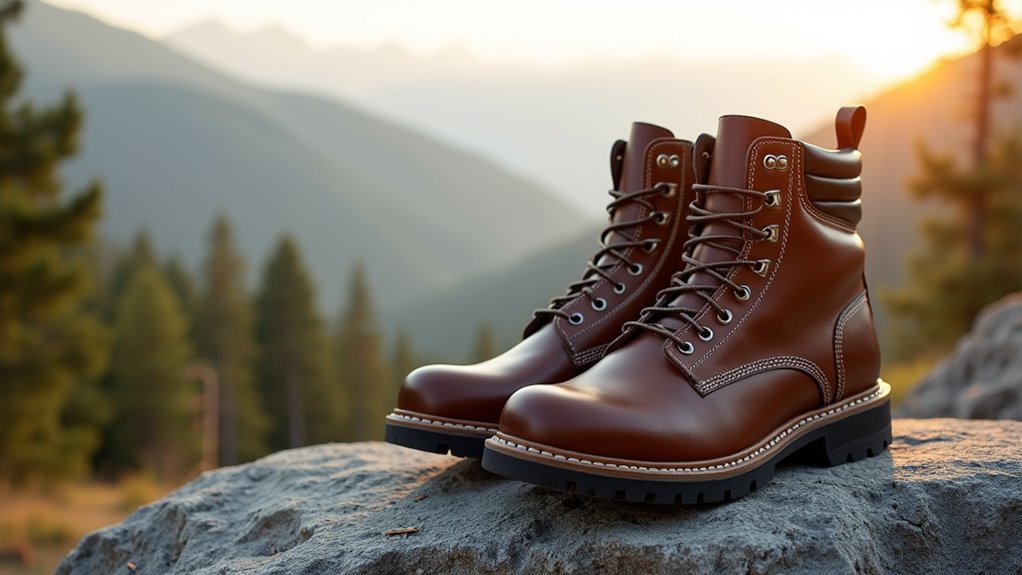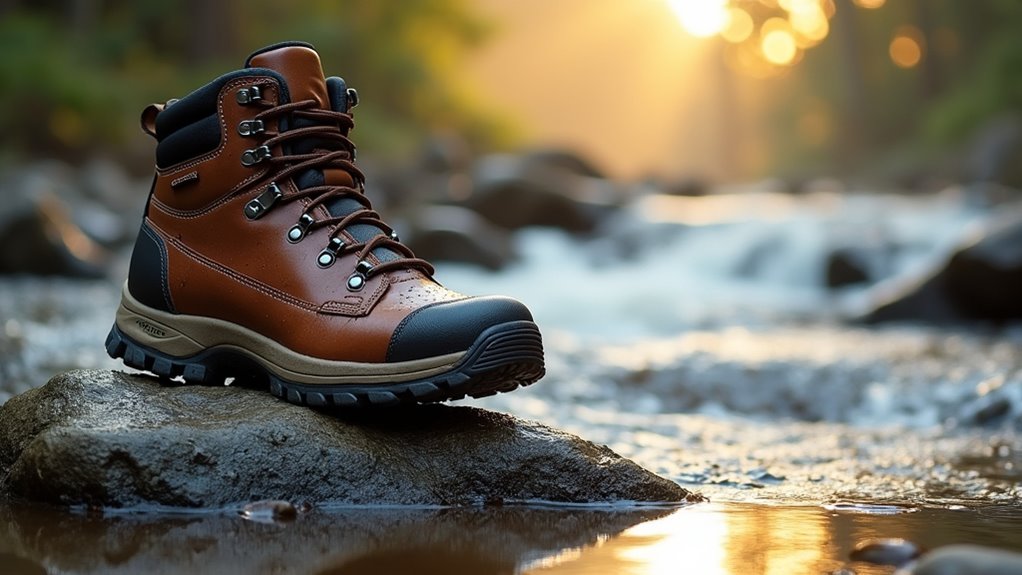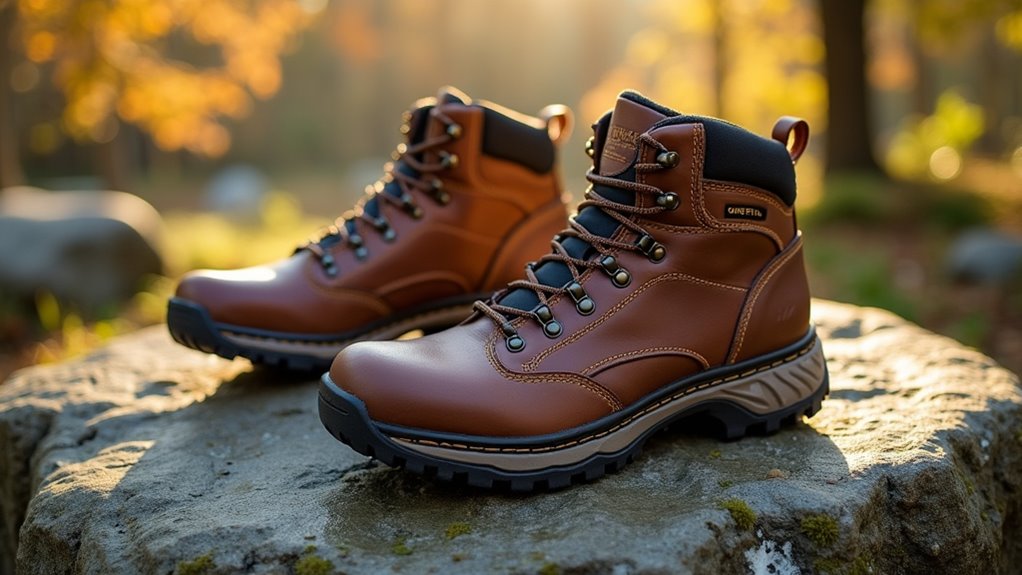Physical Address
304 North Cardinal St.
Dorchester Center, MA 02124
Physical Address
304 North Cardinal St.
Dorchester Center, MA 02124

Master the art of choosing hiking boots that elevate your trail experience, from budget-friendly options to premium trail-ready footwear.
When you’re planning your next trail adventure, you’ll quickly discover that your hiking boots can make or break the experience. Whether you’re tackling rocky summits or crossing stream beds, you’ll need footwear that matches your specific terrain and hiking style. While premium boots can cost upwards of $300, you don’t need to spend a fortune to find reliable protection for your feet. Let’s explore how to select the perfect pair for your outdoor pursuits.

How do you choose the perfect hiking boots when faced with countless options? Start by evaluating where you’ll hike most often. Your local terrain dictates whether you need flexible boots for city trails or stiffer soles for rocky paths.
Consider your typical hiking terrain first – it’s the key to finding boots that match your adventure and ensure lasting comfort.
Consider your typical hiking conditions. If you’re tackling wet environments, you’ll want waterproof materials like Gore-Tex, while hot climates demand breathable synthetic uppers. EVA midsoles provide lightweight cushioning and excellent shock absorption for day hikers.
Don’t forget about the weight you’ll carry – heavy packs require boots with rigid ankle support and stiff soles to prevent fatigue.
Match your boot category to your needs: Category A suits casual walks, while B and above handle tougher trails.
Look at the materials too – full-grain leather lasts longer but costs more and needs breaking in, while synthetic materials offer immediate comfort at a lower price point.
While traditional hiking boots have their place, lightweight trail running boots are revolutionizing how adventurers tackle challenging terrain. You’ll find top performers like the Outpulse Mid GTX at just 13.6 ounces per boot, offering sneaker-like agility without sacrificing protection.
For maximum weight savings, consider the Altra Lone Peak ALL-WTHR Mid 2, weighing only 12-15 ounces depending on size. A proper fit should leave one thumb’s width of space behind your heel for optimal comfort. If you’re seeking more stability, the Salomon X Ultra 4 delivers a perfect balance at 14 ounces.
These lightweight options excel in comfort and versatility, making them ideal for fastpacking and mixed terrain adventures.
Keep in mind that you’ll trade some ankle support and technical terrain capability for the reduced weight. However, features like waterproof membranes and durable outsoles guarantee you’re still well-equipped for most trail conditions.

When tackling wet and muddy trails, proper waterproof boots become your essential line of defense against moisture and discomfort.
You’ll find industry leaders like Gore-Tex and eVent offering top-tier protection, while eco-conscious hikers can opt for nonfluorinated membrane alternatives.
For reliable waterproof performance, consider the Hoka Trail Code GTX at 15.5 oz or the more robust Hoka Kaha 3 GTX with its premium nubuck leather. Long-distance hikers should note that waterproof boots typically have a 900 to 1200 mile lifespan. Essential strategies for cold-weather camping can also be helpful for hikers facing challenging conditions.
The Merrell Moab2 Mid and Salomon X Ultra Mid GTX provide excellent mid-height protection at reasonable weights.
Look for features that’ll keep you dry: gusseted tongues, high ankle collars, and water-resistant fabric uppers.
Don’t overlook construction details like snug heel counters and rigid soles – they’re vital for stability on slick terrain.
Most importantly, make certain your waterproof boots include gaiter attachments for extra protection during stream crossings.
Beyond keeping your feet dry, tackling challenging trails demands boots that can take a beating.
You’ll want full-grain leather uppers with triple stitching and rubber rand reinforcements around the toe and heel areas – these features greatly extend your boots’ lifespan against rough terrain.
Look for boots with hard-wearing Vibram outsoles featuring deep, widely-spaced lugs that’ll grip effectively on loose scree while resisting wear. The Salomon Quest 4 excels here with its beefy lugs providing exceptional traction on steep surfaces.
For serious mountain adventures, choose models weighing over 17.6 oz per boot; the extra weight translates to better protection and stability.
Top-rated durability masters typically include high ankle collars, firm heel counters, and protective toe caps to guard against impacts. Essential camping water filters can also be crucial for ensuring access to clean drinking water during outdoor adventures.
When shopping, check the durability ratings – leading brands like Merrell and Lowa consistently score 4-5 on abrasion resistance tests.

Three essential components define a truly stable hiking boot: robust ankle support, torsional rigidity, and an ergonomic footbed design.
You’ll find these features in boots like the Adidas Terrex Swift R3 GTX, which excels at preventing excessive foot movement on challenging trails.
Look for boots with high collars that offer extra padding around your ankles, coupled with built-in arch support systems that reduce overpronation.
The best stability-focused boots include Pro-Moderator technology to minimize fatigue during long hikes.
You’ll want deep lugs and high-quality rubber outsoles for reliable traction across varied terrain. Lab tests show that 4.4 mm lugs provide superior grip on technical trails.
Don’t overlook the importance of a well-designed toe box and heel cradle.
These features work together with waterproof materials like Gore-Tex to keep your feet secure and stable, regardless of trail conditions. Winter Camping Boots are Essential for adventures in cold-weather environments.
Building on the principles of stability, selecting the right boots for long-distance adventures requires careful consideration of multiple factors.
For extended treks, you’ll need to focus on boots that excel in durability and comfort. The Salomon Quest 4 GTX offers excellent cushioning and a secure lacing system, while the KEEN Pyrenees differentiates itself with its premium nubuck leather and impressive durability ratings. Testing boots on an incline with a force gauge test helps determine their overall stiffness and stability.
If you’re hiking in varied weather, consider the Meindl Bhutan’s versatile performance across seasons. Look for boots with ample toe box space, like the Pyrenees’ 108.0mm width, to accommodate foot swelling and thick socks. Essential gear for your next camping adventure can also provide valuable insights for your boot selection.
While waterproofing is essential, remember that it often reduces breathability – the Pyrenees performs best below 50°F. Your choice should balance protection against elements with comfort for those long miles ahead.
You’d think spending a fortune on hiking boots would guarantee blister-free adventures, but sometimes the most practical pairs won’t break your bank. While those $300 elite models catch your eye, don’t overlook mid-range options that offer similar features at half the price. Focus on what you’ll actually need – whether it’s waterproofing for rainy trails or lightweight design for quick ascents. Smart shopping saves both your feet and wallet.